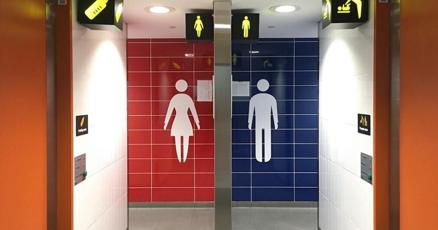
Restrooms can be challenging places to navigate for some trans and intersex people, as evidenced by the death of 16-year-old Nex Benedict in Oklahoma.
When it comes to providing safe and inclusive bathrooms for transgender individuals, Oklahoma is not an exception. According to the Movement Advancement Project, which tracks LGBTQ+ policies, 13 states have policies that restrict transgender individuals from using communal facilities in a manner that aligns with their gender identity.
However, statistics show that transgender and nonbinary individuals report high levels of harassment in public restrooms even in states with transgender-friendly policies. Advocates argue that ordinary individuals can make a significant impact by combating discrimination in gendered restrooms. The 19th illustrates how anyone can help prevent misuse.
Acknowledge that bathrooms can be intimidating and help find inclusive alternatives.
Tat Bellamy-Walker, a Seattle-based columnist and Black gender-fluid trans person, has experienced segregated restrooms as unwelcoming environments. They had to go out of their way to find all-gender single-stall restrooms where they could use the facilities comfortably during grad school and internships.
“You never forget being told you don’t belong in a space; you always remember not having a place to dispose of hygiene products if you’re on your period in a public restroom,” Bellamy-Walker said. “It’s crystal clear you don’t fit into public spaces.”
Friends can be a tremendous support by locating and recommending gender-neutral restrooms to friends or family members who may need them. This is particularly crucial when planning events or gatherings. Ensure that your venue has accessible bathrooms.
Offer to accompany your friends who are transgender or nonbinary to the restroom.
Carrie Soto, a South Dakota parent of a transgender child, lives by the motto “see something, say something.”
This includes intervening in a public restroom or offering to accompany a transgender/nonbinary friend or family member who is being harassed or bullied.
“Assess a transgender person’s fears and discomfort about the situation,” Soto said. “If my daughter uses a gendered restroom and feels anxious, I go with her.”
When you encounter transgender and nonbinary individuals in restrooms, greet them and make them feel welcome.
Although it may seem simple, transgender health advocate Jamison Green points out that this gesture can greatly contribute to making trans people feel safe. Consider that, according to the 2015 U.S. Transgender Survey, 59 percent of transgender individuals avoided using public restrooms due to fear of harassment. Additionally, data from 2022 indicates that 4 percent of transgender individuals were denied entry to a restroom, and 6 percent reported experiencing physical or verbal assault while using one.
“If you see someone who you perceive as trans or genderfluid, simply smile or offer them a non-confrontational compliment… Wish them a good day or evening, and move on,” Green said. “Of course, that only applies to the women’s restroom! In the men’s restroom, talking is quite rare.”
Green suggests that transgender individuals respond with a kind, unapologetic nod.
Advocate for more gender-inclusive options.
Twenty-two states and Washington, D.C., allow residents to choose an “X” gender marker on their IDs in addition to selecting “M” or “F.” However, in many places, regardless of legal provisions, most restrooms in state buildings, schools, businesses, places of worship, and social institutions are gendered.
Activists suggest that individuals can advocate for more inclusive options by simply asking organizations and building managers to provide facilities that accommodate all genders.
Lambda Legal emphasizes that “advocacy is the most critical aspect of the fight for transgender rights” in its restroom toolkit. Employers proactively adopting pro-trans policies are far less likely to encounter issues than those waiting for transgender individuals to lead the way.
If you don’t require the use of single-stall gender-neutral restrooms, consider leaving them available.
The few single-stall gender-neutral restrooms available often have queues that are unsuitable for a news article about people utilizing them for… well, using them. Consequently, gender-neutral restrooms, especially in public spaces, are almost always occupied.
There are numerous reasons why a cisgender person might need a single-occupancy restroom (accessibility, illness, child care, and yes, even a bit more privacy). It’s considerate to leave gender-neutral restrooms unoccupied when you don’t need them, just like accessible stalls.



